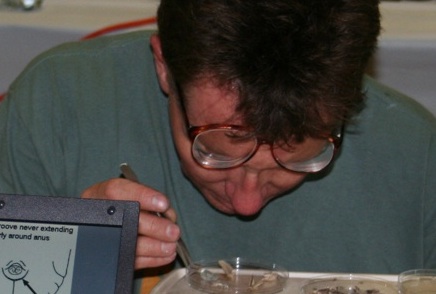CAES Tick Grant Puts Life Cycle Under Scrutiny

Ticks are small in size but the even tinier organisms they may carry and transmit when they feed on mammals with two legs or four have large implications for humans, livestock and companion animals.
 The Centers for Disease Control and Prevention (CDC) has awarded a cooperative agreement (grant) for research to The Connecticut Agricultural Experiment Station (CAES) on an integrated and individual tick management program to reduce the risk of Lyme disease.
The Centers for Disease Control and Prevention (CDC) has awarded a cooperative agreement (grant) for research to The Connecticut Agricultural Experiment Station (CAES) on an integrated and individual tick management program to reduce the risk of Lyme disease.
Lyme disease continues to be the leading arthropod-associated human disease in Connecticut and the United States. There were 3,041 confirmed or probable cases of Lyme disease reported in Connecticut in 2011, which likely represents only 10% of the diagnosed cases.
Chief Entomologist Dr. Kirby C. Stafford III is lead investigator. Dr. Goudarz Molaei, molecular scientist, and wildlife biologist, Dr. Scott Williams are co-investigators. Dr. Anthony DeNicola from White Buffalo, Inc., will also participate. The project will provide $300,000 each year for the three-year-project period from Sept. 1, 2012 to Aug. 31, 2015.
“This grant will support critical field research on a very important public health problem in Connecticut and many other states” said Dr. Louis A. Magnarelli, CAES director.
Dr. Stafford noted that “this funding will allow us to evaluate some the tick control strategies that we have been testing over the years in an integrated approach to reduce the population of the blacklegged tick (i.e., deer tick) that transmits the pathogens for three human diseases. More than 24% of the ticks from Redding that were tested last year were infected with the Lyme disease spirochetes.
This study is being conducted in cooperation with the town of Redding, where various tick control measures will be evaluated singly or in combination on their ability to reduce the tick population in participating neighborhoods.
Information on the ticks, disease agents they transmit, personal protection measures, and tick management approaches can be found in the Tick Management Handbook at www.ct.gov/caes.
Worth repeating: When at events that involve horses, livestock and dogs, I always inquire about any experiences with tick-borne diseases (TBD). An alarmingly number of folks report battles with not only Lyme disease but also other TBDs – in themselves, their dogs and horses. Remember that regarding your canine or equine companions – it's best to do daily tick checks, use topicals such as Frontline or Parastar, and seek veterinary advice and support in the form of annual testing to screen for diseases. Speak up if a pet seems “funny, not quite right, but I can’t put my finger on why” as diagnostic lab tests can reveal clues for early detection. And be persistent.

Green and lush open space meadows – people walk here daily with dogs and ride their horses on the paths that lead through the woods.
An interesting study in the U.S. National Library of Medicine National Institutes of Health sheds light on the changes in predators and possible correlation to the rise in Lyme disease:
“We present a theoretical model that illustrates how reductions in small-mammal predators can sharply increase Lyme disease risk. We then show that increases in Lyme disease in the northeastern and midwestern United States over the past three decades are frequently uncorrelated with deer abundance and instead coincide with a range-wide decline of a key small-mammal predator, the red fox, likely due to expansion of coyote populations.”
– from “Deer, Predators, and the Emergence of Lyme disease” a report on PubMed from Departments of Environmental Studies, Center for Integrated Spatial Research, Ecology and Evolutionary Biology, and Applied Math and Statistics, University of California, Santa Cruz, linked here.
Recommendations from the Center for Disease Control (CDC) to remove attached ticks:
• Grasp the tick as close to the skin surface as possible. Use fine-tipped tweezers or notched tick extractor, and protect your fingers with a tissue, paper towel, or latex gloves (see figure on CDC site). Persons should avoid removing ticks with bare hands.
• After removing the tick, thoroughly disinfect the bite site and wash your hands with soap and water.
• Do not squeeze, crush, or puncture the body of the tick because its fluids may contain infectious organisms, including babesiosis, Lyme disease, and ehrlichiosis.
Note: Folklore remedies such as petroleum jelly or hot matches do little to encourage a tick to detach from skin. In fact, they may make matters worse by irritating and stimulating it to release additional saliva, increasing the chances of transmitting the pathogen.
• One of the most effective ways to dispose of a tick is to keep a small bottle with a tight cap half full of alcohol – in your vehicle and another one at home.
• Keep grass mowed short (sunlight and dryness are enemies of ticks) near your home.
_______________________________________________________________________
“Yipe!” is what frogs say when spooked. A fair coming up with a special froggy contest.
